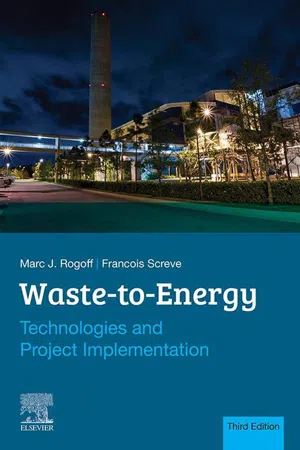
Waste-to-Energy
Technologies and Project Implementation
Marc J. Rogoff,Francois Screve
- 228 pages
- English
- ePUB (adapté aux mobiles)
- Disponible sur iOS et Android
Waste-to-Energy
Technologies and Project Implementation
Marc J. Rogoff,Francois Screve
À propos de ce livre
Waste-to-Energy: Technologies and Project Implementation, Third Edition covers the programs and technologies that are available for converting traditionally landfilled solid wastes into energy through waste-to-energy projects. It includes coverage of the latest technologies and practical engineering challenges, along with an exploration of the economic and regulatory context for the development of WTE. In addition to technology itself, the book explores implementation concepts, waste feedstock characterization and flow control. It also delves into some of the key issues surrounding the implementation of waste-to-energy systems, such as site selection, regulatory aspects, and financial and economic implications.
Professionals working on planning and implementing waste-to-energy systems will find the book's practical approach and strong coverage of technical aspects a big help to their initiatives. This is a must-have reference for engineers and energy researchers developing and implementing waste-to-energy conversion systems.
- Explores the most currently available technology for waste-to-energy conversion from municipal solid wastes
- Includes recent case studies from around the world that provide insights into the different approaches to planning and implementation of WTE
- Completely updated with the latest technology
- Expanded to include information on thermochemical and biochemical conversion systems
Foire aux questions
Informations
Introduction and Overview
Abstract
Keywords
1.1 The Growing Solid Waste Disposal Problem
| Region | Total urban population (millions) | Urban MSW generation per capita (kg/day) |
|---|---|---|
| Africa | 518 | 0.85 |
| East Asia and Pacific | 1230 | 1.52 |
| Eastern and Central Asia | 240 | 1.48 |
| Latin America and Caribbean | 466 | 1.56 |
| Middle East and North Africa | 257 | 1.43 |
| OECD | 842 | 2.07 |
| South Asia | 734 | 0.77 |
| Total | 4287 | 1.42 |
Table des matières
- Cover image
- Title page
- Table of Contents
- Copyright
- About the Authors
- Preface
- Acronyms and Abbreviations
- Chapter 1. Introduction and Overview
- Chapter 2. Project Implementation Concepts
- Chapter 3. Energy From Waste Technology
- Chapter 4. Solid Waste Composition and Quantities
- Chapter 5. Waste Flow Control
- Chapter 6. Selecting the Facility Site
- Chapter 7. Energy and Materials Markets
- Chapter 8. Permitting Issues
- Chapter 9. Procurement of Energy From Waste Systems
- Chapter 10. Ownership and Financing of Waste-to-Energy Facilities
- Chapter 11. Operations and Maintenance of Waste-to-Energy Facilities
- Appendix A. Glossary of Important Terms
- Appendix B. Waste-to-Energy Case Studies
- Index